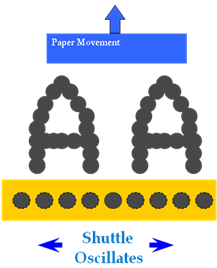Line matrix printer
A line matrix printer is a computer printer that is a compromise between a line printer and a dot matrix printer. Basically, it prints a page-wide line of dots. It builds up a line of text by printing lines of dots.
Applications
Line matrix printers are used for high-speed printing applications in industries such as manufacturing, banking, supply chain and back office environments. In these high-volume printing industries, line matrix printers are used to produce invoices, bank statements, product shipment and transportation documentation as well as product compliance labels.
Line matrix printers can print text, bar codes and graphics. Line matrix printers were originally popularized by the mini-computer craze and continued its growth as a bar code printer. Today they are sold in virtually every corner of the world and while they print as rapidly as lineprinters, they can print bar codes and other graphics as well. When implemented as impact printers, they can be the least expensive to operate per page.
How It Works
Often considered the "backbone" of many industrial and back-office systems, there are several types of line matrix printers used today across diverse enterprise production environments including: manufacturing, supply chain, distribution & logistics, transportation, finance and banking. Dot matrix printers, also known also as impact printers, represent the oldest printing technology, are still widely used today, due to its lowest 'cost per page' ratio. Dot matrix printers are divided on two main groups: serial dot matrix printers and line matrix [1] printers.

A serial dot matrix printer is a type of computer printer with a print head that runs back and forth, or in an up and down motion, on the page and prints by impact, striking an ink-soaked cloth ribbon against the paper, much like the print mechanism on a typewriter. However, unlike a typewriter or daisy wheel printer, letters are drawn out of a dot matrix, and thus, varied fonts and arbitrary graphics can be produced. Because the printing involves mechanical pressure, these printers can create carbon copies and carbonless copies.
Both line matrix and serial dot matrix printers, use pins to strike against the inked ribbon, making dots on the paper and forming the desired [2] characters. The differences are that line matrix printers use a hammer bank (or print-shuttle) instead of print head, this print-shuttle has hammers instead of print wires, and these hammers are arranged in a horizontal row instead in vertical column. The hammer bank uses the same technology as the permanent magnet print head with the small difference that instead of print wires the print-shuttle has hammers.
The permanent magnetic field holds the hammer spring in stressed, ready to strike position. The driver sends electrical current to hammer coil, which then creates electromagnetic field opposite to the permanent magnetic field. When both fields equalize, the energy stored in the spring is released to strike the hammer against the ribbon and prints a dot on the paper.
During the printing process the print-shuttle vibrates in horizontal direction with high speed while the print hammers are fired selectively. Each hammer prints a series of dots in horizontal direction for one pass of the shuttle, then paper advances at one step and the shuttle prints the following row of dots
Line Matrix Printers versus Laser Printers
For years laserprinters have been the popular choice, however line matrix printers have improved technological aspects and now claim to hold significant benefits over laser printers in terms of energy savings, cost per page, reliability in industrial environments and media flexibility (multipart forms, oversize media, peel off labels, cloth, or card stock). Every aspect of the line matrix printer is designed to deliver higher reliability, fast throughput, and greater resistance to rough handling and hazardous environmental conditions. The result is a product that provides a substantially lower cost over the life of the product. Industry today continues to use line matrix in the print production of mission critical business document production. These documents are critical to keeping the enterprise operation functioning. If these documents don't print the business workflow stops.
Emerging Technology
Line matrix technology continues to advance based on the need to support modern IT environments. Examples of emerging technologies include:
- Developing longer lasting ink cartridges.[3]
- Integrating a "Plug and Print" solution.
- Adding new language support, expanded bar code symbologies[4] and system interface enhancements
- Adding remote printing management systems.
References
- ↑ "Red Hat Enterprise Linux 3: Introduction to System Administration". Red Hat. Retrieved 9 February 2012.
- ↑ Ohta, Rosen, Noburu, Mitchell (2005). Engineering of the color desktop printer ([Online-Ausg.] ed.). Boca Raton: CRC/Taylor & Francis Group. p. 87. ISBN 0-8247-5364-X.
- ↑ "Printronix Launches P7000 Cartridge Series of Line Matrix Printers into Latin American Market". Businesswire. Retrieved 31 January 2012.
- ↑ "Printronix Whitepaper: Technology Breakthrough Advances Line Matrix Printing – Allows for Direct Competition with Laser Printers in Most Industrial Settings". Printronix. Retrieved 31 January 2012.